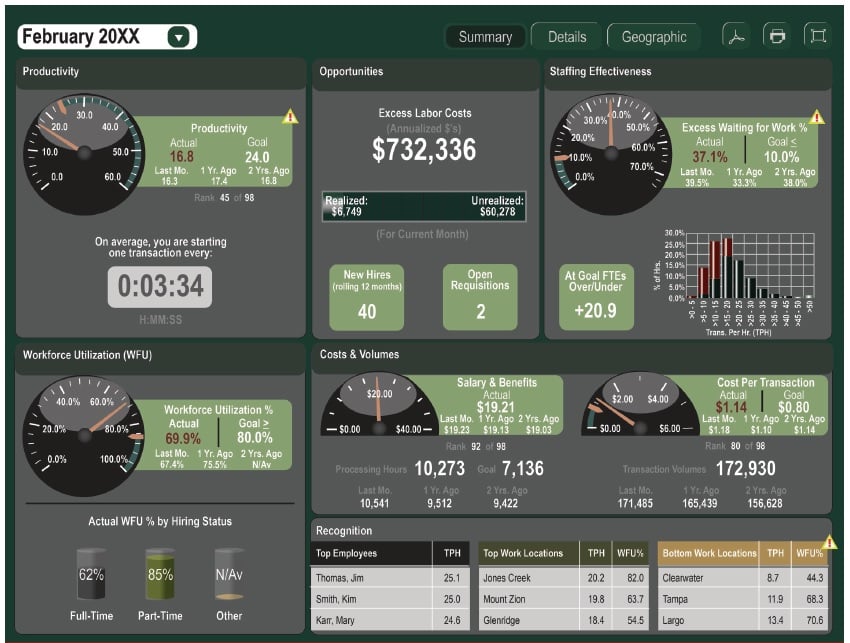Wasted labor expense is one of the biggest threats to profit margins in branches and call centers.
Staffing operational costs, which typically account for 70-80% of a credit union's budget, can be severely affected by under- and overstaffing, according to a white paper by St. Louis-based workforce management vendor Pipkins, which provides staffing software for the $60.4 billion Navy Federal Credit Union in Vienna, Va.
At the branch level, cooperatives that don't refine staffing strategies can also incur significant and costly inefficiencies as transactions drop with members shifting to other channels.
Recommended For You
Idle time can account for up to 30% of the time a credit union employee spends during paid working hours at the branch, according to a 2013 study by Atlanta-based FMSI, a workforce optimization vendor.
By reining in labor costs, credit unions can shift assets toward improving service and products. For example, the $1.3 billion Community First Credit Union of Florida in Jacksonville, cut labor costs by $1 million annually by switching to an automated staff scheduling system that optimized staffing across 17 branches.
"In our first year, we saved $1 million in hard dollars in teller staffing," said Michael Tomko, SVP of operations at Community First.
Before automating the scheduling process, the credit union experienced many challenges.
"The branches always seemed to want more staff," Tomko explained. "They wanted to be comfortable that they could handle any rush of members without any wait. Historically, that was the expectation of the credit union, but that is no longer possible. It was always frustrating for me to try and determine who may really need extra staff versus a branch manager trying to be extra cautious."
 Hoping to boost efficiency, productivity and the bottom line, Community First implemented FMSI's Omnix Staff Scheduler in 2011. (Click on the Omnix dashboard at left to expand.)
Hoping to boost efficiency, productivity and the bottom line, Community First implemented FMSI's Omnix Staff Scheduler in 2011. (Click on the Omnix dashboard at left to expand.)
"With FMSI and workforce management, I now have real data upon which I can rely to make decisions," Tomko said.
After experiencing significant savings with FMSI's traditional scheduler, Community First recently added FMSI's Whole Branch Scheduling enhancement, which created an optimal schedule for all branches based on analysis of historic and forecasted transactions, Tomko said.
"I greatly look forward to being able to utilize whole branch staffing and cross trained staff to be even more efficient," he added.
Allison Mangini, branch support and special services manager at Community First, said the recent upgrade will enable the credit union to predict account holder traffic for the platform area of branches, achieve lower labor costs and provide better service.
"The upgraded FMSI scheduler will also help us better manage our universal associates in our lower volume branches," Mangini said. "Naturally, these types of branches have more employee idle time, and FMSI's solution will be instrumental in identifying these periods, and then assisting us in assigning more meaningful and productive tasks."
The credit union is already noticing important details, Tomko said.
"As we look at our first round of reporting, we are seeing that there is disparity among branches in terms of servicing members and the number of staff on board," he explained. "As we begin to examine specific schedules by branch, I am convinced we will be able to redistribute staff among branches to match the resource to the demand."
For other credit unions contemplating whether to automate staff scheduling, Tomko offered this advice: "I would recommend everyone do it. It is a lot of work and you have to be absolutely diligent to get the best results, but in the end, the efficiency gained and improved member service is well worth every bit of effort."
Many other credit unions have experienced significant improvements in efficiency and productivity by automating their staff scheduling, reporting and tracking, said W. Michael Scott, president/CEO of FMSI.
"Maintaining teller staffing at the ideal level to ensure customer satisfaction can sometimes be a very credit union specific decision," Scott noted. "Adjusting staffing models and changing how they are managed on a daily basis is a prime area for improved efficiencies and sales, yet most institutions don't have the information or resources at hand to make this kind of complex adjustment."
After quantifying their idle time with FMSI's new scheduler, the company's clients have been surprised at how much downtime is actually occurring in their workplace, Scott said.
"With our enhanced system, they can significantly redirect and then minimize employee downtime in all areas of the branch."
© Touchpoint Markets, All Rights Reserved. Request academic re-use from www.copyright.com. All other uses, submit a request to [email protected]. For more inforrmation visit Asset & Logo Licensing.






